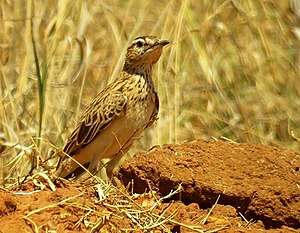Bechuana Lark
| Bechuana Lark | ||||||||||||
|---|---|---|---|---|---|---|---|---|---|---|---|---|

Bechuana Lark |
||||||||||||
| Systematics | ||||||||||||
|
||||||||||||
| Scientific name | ||||||||||||
| Certhilauda chuana | ||||||||||||
| ( Smith , 1836) |
The Bechuana lark ( Certhilauda chuana ), also called acacia long-billed lark or Bechuan lark , is a species from the lark family. Their distribution area is in the south of Africa. It is slightly larger than a skylark and is reminiscent of a pipit in its habitus . No subspecies are distinguished.
The population of the Bechuana lark is classified as least concern .
features
The Bechuana lark reaches a body length of 19 to 20 centimeters, of which 7.5 to 7.9 centimeters are on the tail. The beak has a length of 1.6 to 2 centimeters. It weighs about grams. There is no gender dimorphism .
The Bechuana lark has a grayish-brown upper body with strong black stripes. The stripe above the eyes as well as the chin and throat are white. The goiter and chest are yellowish brown with dark speckles. The rest of the underside of the body is whitish. The wings are black-brown, the hand wings are lined with red-brown. The tail is also black-brown, the outermost rudder feather is lined with sand-colored. The beak is dark horn-colored. The feet and legs are reddish brown. The iris is brown.
Distribution area and habitat
The Bechuana lark is found in the Republic of South Africa and in the southeast of Botswana. Their habitat are open, semi-arid steppes, dry thorn savannahs and acacia savannas on the edge of sparsely populated forest areas.
Way of life
Reproductive biology has not yet been adequately studied. It eats insects and grass seeds.
literature
- Rudolf Pätzold: The larks of the world . Westarp Sciences, Magdeburg 1994, ISBN 3-89432-422-8 .
Web links
Single receipts
- ↑ Avibase on the Bechuana Lark, accessed on January 8, 2017
- ↑ Pätzold: The larks of the world . P.56.
- ↑ Pätzold: The larks of the world . P. 58.
- ↑ Pätzold: The larks of the world . P. 57.
